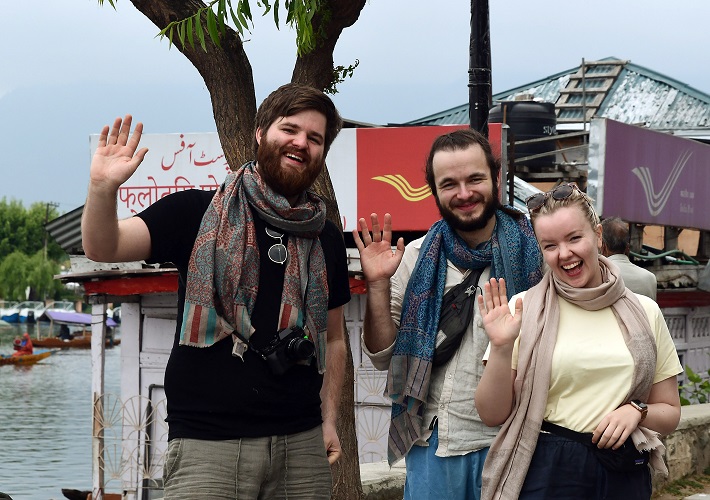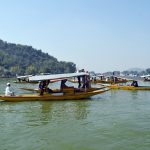Kashmir, often referred to as “Paradise on Earth,” is renowned for its stunning scenic beauty, picturesque landscapes, breathtaking mountain ranges, serene lakes, snowcapped peaks, lush greenery, and a rich cultural heritage. Nestled in the northernmost part of India, this region has long been a favorite destination for travelers seeking tranquility and adventure. Kashmir’s natural resources and cultural wealth offer tremendous potential for economic growth, with the tourism sector playing a pivotal role in driving the local economy. Over the years, tourism has emerged as one of the most prominent sectors in the region, providing employment, encouraging cultural exchange, and contributing significantly to economic development.
The Role of Tourism in Kashmir’s Economy
Tourism in Kashmir has flourished despite intermittent challenges, including political unrest and the global COVID-19 pandemic. The region has been able to attract both domestic and international tourists with its unique blend of natural beauty and rich cultural offerings. The industry directly and indirectly employs thousands of locals, including hotel staff, tour operators, taxi drivers, and artisans, fostering economic growth and supporting various ancillary sectors.
The Jammu and Kashmir Tourism Department has reported significant growth in tourist arrivals in recent years, particularly after the abrogation of Article 370 in August 2019. The subsequent political stability and government initiatives have led to a resurgence in tourism. According to data provided by the Ministry of Home Affairs (MHA), Jammu and Kashmir recorded 1.89 crore tourist arrivals by December 2022, the highest in the past 75 years. This surge highlights the immense potential of tourism to drive economic development in the region.
The tourism sector contributes around Rs. 8,000 crore annually to the local economy, accounting for nearly 7% of the region’s Gross State Domestic Product (GSDP). It provides direct and indirect employment to approximately 70,000 people. From 2021 to 2023, tourism in Jammu and Kashmir grew at an impressive annual average rate of 15.13%. The state government’s efforts to promote and enhance tourism have played a crucial role in boosting this sector, making it a cornerstone of the region’s economy.
2022-23: A Record-Breaking Year for Tourism
The year 2022 marked a turning point for the tourism industry in Jammu and Kashmir. In the wake of the COVID-19 pandemic, the region saw a sharp rise in tourist arrivals, signaling a robust recovery and growth trajectory. A total of 1,88,64,332 tourists visited Jammu and Kashmir in 2022, surpassing all previous records. This impressive figure reflects the success of government initiatives aimed at promoting tourism and enhancing infrastructure.
The momentum continued in 2023, with an all-time high of 2,11,24,674 tourist arrivals, further cementing Kashmir’s position as a premier tourist destination in India. The region’s ability to attract such large numbers of visitors, even in the face of global challenges, is a testament to its enduring appeal. The Ministry of Home Affairs reported that 1,08,41,009 tourists visited Jammu and Kashmir in the first six months of 2024 alone, setting the stage for another record-breaking year.
Government Initiatives: Boosting Tourism and Infrastructure
The resurgence of tourism in Kashmir can be attributed in large part to the proactive policies and initiatives undertaken by the government of Jammu and Kashmir. The Comprehensive Tourism Policy, launched in 2020, set ambitious goals for the sector. It aimed to generate employment for approximately 50,000 people per year and attract an average investment of Rs. 2,000 crore annually over the next five years. The policy also focuses on sustainable tourism practices, ensuring that economic development is balanced with environmental preservation.
In addition to the Tourism Policy, the Jammu and Kashmir Industrial Policy 2021 has granted the tourism sector the status of an industry, allowing stakeholders to avail incentives and benefits traditionally reserved for industrial sectors. This has encouraged private investment in the region, particularly in the development of hotels, resorts, and other tourism-related infrastructure.
The government has also implemented several policies to improve accommodation options and enhance the overall tourist experience. The Homestay Guidelines aim to encourage locals to offer homestay services, thereby increasing the capacity to accommodate tourists while also providing economic benefits to residents. The Houseboat Policy 2020 seeks to preserve the iconic houseboats on Dal Lake while ensuring their sustainability.
Furthermore, the government has been actively promoting Border Tourism, opening up previously inaccessible locations such as Gurez, Keran, Teetwal, and R S Pura to visitors. This has diversified the tourist offerings and created opportunities for adventure and off-beat tourism. Additionally, Jammu and Kashmir has emerged as a prime location for Golf Tourism and Adventure Tourism, attracting enthusiasts from around the world.
Infrastructure Development: A Key Driver for Growth
Recognizing the importance of modern infrastructure in supporting tourism, the government has undertaken several large-scale infrastructure projects. Improved road connectivity, the expansion of Srinagar International Airport, and the construction of new hotels and resorts have all contributed to the sector’s growth. These infrastructure developments have also paved the way for MICE Tourism (Meetings, Incentives, Conferences, and Exhibitions) and Destination Weddings, both of which have gained popularity in recent years.
One of the most significant developments in 2023 was the successful hosting of the 3rd G-20 Tourism Working Group Meeting in Srinagar. This event not only showcased Jammu and Kashmir as an emerging international tourist destination but also demonstrated its capacity to host major global events. The resulting international exposure has further enhanced Kashmir’s appeal as a tourist destination.
Challenges in Kashmir’s Tourism Sector
While the tourism sector in Kashmir has experienced remarkable growth, several challenges remain that need to be addressed to unlock its full potential.
- Infrastructure Deficits: Despite improvements, many remote areas still lack basic infrastructure such as reliable road networks, electricity, and internet connectivity. These shortcomings hinder the expansion of tourism to lesser-known destinations and limit the region’s ability to offer a seamless tourist experience.
- Political Instability: Intermittent political unrest in the region continues to affect tourist confidence. Although the situation has stabilized in recent years, further efforts to ensure peace and security are essential for long-term tourism growth.
- Environmental Concerns: The rapid growth of tourism poses a threat to the delicate ecosystems of Kashmir. Popular tourist destinations like Dal Lake have experienced pollution and overcrowding, leading to environmental degradation. It is crucial to adopt sustainable tourism practices to protect the region’s natural resources for future generations.
- Seasonality of Tourism: Tourism in Kashmir is largely seasonal, with peak seasons during summer and winter. Efforts to promote year-round tourism, particularly in off-peak months, are essential for sustaining employment and generating consistent revenue.
Sustainable and Diversified Tourism: The Way Forward
To address these challenges and ensure the long-term success of the tourism sector, the government and stakeholders must adopt a holistic approach focused on sustainable and diversified tourism practices. Eco-tourism, adventure tourism, and cultural tourism offer immense potential to attract visitors throughout the year while minimizing the environmental impact.
Promoting Eco-Tourism can help conserve natural resources while providing economic opportunities for local communities. Activities such as nature trails, bird watching, and responsible wildlife tourism can draw environmentally-conscious travelers. Adventure Tourism, including trekking, skiing, and river rafting, also has the potential to attract younger audiences and promote year-round tourism.
Cultural Tourism is another avenue that can be explored to diversify the tourist offerings. Kashmir’s rich cultural heritage, including its traditional crafts, music, and festivals, can be leveraged to create unique experiences for tourists. Initiatives such as cultural circuits and heritage tours can showcase the region’s diverse history and traditions.
Kashmir’s tourism sector has emerged as a crucial driver of economic growth, creating employment opportunities, promoting cultural exchange, and boosting local businesses. The record-breaking tourist arrivals in 2022 and 2023 highlight the region’s immense potential as a top destination for domestic and international travelers.
With continued government support, infrastructure development, and a focus on sustainable tourism practices, the future of Kashmir’s tourism industry looks promising. By addressing challenges such as infrastructure deficits and environmental concerns, the region can further capitalize on its natural beauty and cultural heritage to become a shining example of economic and social development.
The tourism sector in Jammu and Kashmir is not just an economic lifeline but also a vehicle for peace, prosperity, and cultural preservation. As the region continues to evolve, it is poised to reclaim its status as one of the most sought-after tourist destinations in the world, offering a unique blend of natural splendor and rich tradition.
(Author is a Columnist and can be reached at: [email protected])








